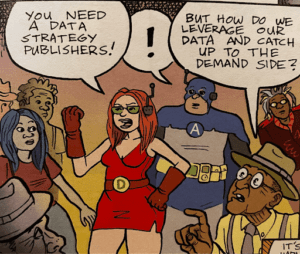Here’s today’s AdExchanger.com news round-up… Want it by email? Sign-up here.
Trust Busted
“We are going to have to decide fairly soon whether Google, Facebook and Amazon are the kinds of natural monopolies that need to be regulated, or whether we allow the status quo to continue, pretending that unfettered monoliths don’t inflict damage on our privacy and democracy,” Jonathan Taplin writes for The New York Times. If platforms were treated as regulated monopolies, Google, for example, would license patents to use its search algorithms or ad exchanges for a small fee, like AT&T once did for the telecom industry, Taplin writes. Read it. On the other hand, the last decade’s would-be monopolists (Microsoft, Yahoo) were stymied by the next big thing.
Act Local
On the tails of its 2016 ReachLocal acquisition, Gannett has acquired SweetIQ, which manages location data, consumer reviews and offline attribution for local businesses. The asset will be integrated with ReachLocal, which Gannett has now rolled out in all 109 markets where it operates. More at (Gannett-owned) USA Today. Is the small biz market ready for its big date with data? See also Yext’s bubbly IPO.
Moving On
Two years on, Turn’s battle with the FTC over its use of zombie cookies to target opted-out Verizon wireless customers has finally run its course. Turn must provide an “effective opt-out” for consumers who don’t consent to targeted advertising and place a “prominent hyperlink” on its home page pointing to a privacy disclosure, the FTC said. “The FTC consent order bars Turn from misrepresenting the extent of its online tracking or the ability of users to limit or control the company’s use of their data,” the FTC wrote in a press release. Read it.
Right For Who?
The idea of the “right price” is changing every day. Sometimes even many times a day. Take Amazon, which boggles consumers by offering prices that seem to be “vibrating between two quantum states,” writes The Atlantic. The variable costs you might associate with hotels, airlines and Uber surge pricing are being applied to ecommerce and advertising in powerful and concealed ways. A lot of Amazon’s glitch-like oscillations are just testing in pursuit of a theoretically ideal price. More.
But Wait, There’s More!
- Performance Is New Programmatic In TV Advertising – MediaPost
- Verizon Customers Defect As Competition Ramps Up – WSJ
- The Guardian Pulls Out Of Instant Articles And Apple News – Digiday
- State Of Native Advertising 2017, According To Publishers – release
- Cities Seek Deliverance From The Ecommerce Boom – City Lab
- The Exec Shuffle When Yahoo-Verizon Closes – Business Insider
- BIA/Kelsey And comScore Release Local TV Ad Market Report – release
- Google Home Rolls Out Multi-User Support Feature – CNBC
- Facebook Is Paying Pubs To Create Produced Video – Recode
- Thunder Partners With The Kepler Group – release










